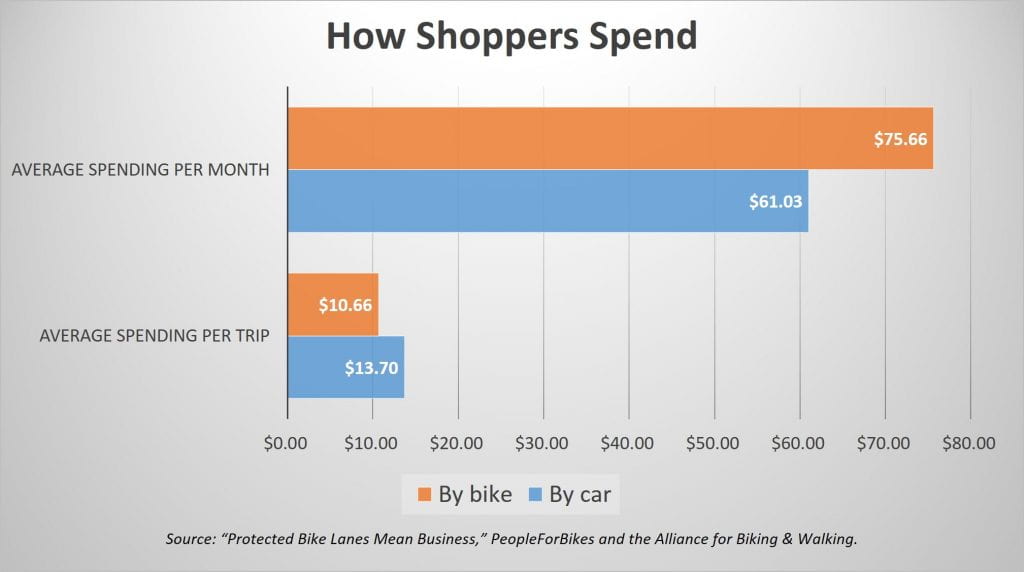by Jeffrey L Garceau
Residents of many major cities have become accustomed to seeing bicycle lanes on their streets and bicycle sharing services popping up in their neighborhoods, in an attempt to accommodate and foster non-motorized travel. People with concerns about the environment and maintaining an active lifestyle see obvious benefits from this trend. Local governments also see benefits to reduced traffic congestion and benefits to public health. Much of the advantages of increasing the number of biking pedestrians are realized if a community makes investments in providing adequate infrastructure to support residents trading automobiles for bicycles or their own two feet.
The Urban Land Institute has released a new report giving residents and city officials another reason to consider investing in active transportation projects and services; it has a positive effect on real estate prices. A few of the numerous studies highlighted in the report:
— Indianapolis, Indiana – Properties along the Indianapolis Cultural Trail saw their values increase an average of 148% from 2008-2014. A $62.5 million investment has increased the real estate value of the surrounding community by $1.01 billion.
— Dallas, Texas – The Katy Trail in Dallas was built in 2006. Since then, adjacent property values have climbed 80%.
— Minneapolis, Minnesota – A study found that for every 1,312 feet (400 meters) a property was closer to an off-street bicycle facility, its value was increased by $510.
The implementing of biking/walking infrastructure has been shown to increase economic activity as well, particularly boosting retail sales. Biking shoppers behave differently from driving shoppers. ULI’s report shows they buy less per visit, but visit more frequently, showing that, in a given month, bikers will spend more at local retail stores in total than will drivers. Additionally, biking customers are more likely to become regulars at the places they patron than drivers.
There are two other characteristics of biking customers and employees that are advantageous to retail business owners, and employers in general. First, up to ten bicycles can fit in the space it takes to park a single car. This saves costs on providing parking spaces for customers and employees, and current parking spaces can be easily converted to accommodate bicycles. Second, the health benefits of bicycling need no elaboration, but healthier employees and customers both benefit businesses. Healthier employees save on health insurance benefits in the aggregate, and healthier customers have more disposable income, due to their decreased personal health costs.
From a planning and development perspective, there are benefits to investing in bicycling and walking infrastructure. A healthier populace that shops and dines closer to their places of residence is good for local economic development. Lower automobile use and congestion is good for the local environment. The maintenance costs of pedestrian pathways are lower than the wear and tear caused by auto traffic. Pedestrian infrastructure frees up all kinds of space that can be dedicated to other purposes. Bicycling trails can bring tourism to a community, and a cycling population will demand services from bicycle retailers, repairers, bike sharing services, and other related businesses.
A successful project is one that can benefit both commuters and leisure riders, and blends into the environment, whether that be a woodland trail or a high-traffic urban center.
MuniNet conducted an interview with Matt Norris, Senior Associate of Content, and Rachel MacCleery, Senior Vice President of Content for the Urban Land Institute, two key authors of the report. We asked about ways that highly urbanized areas can implement more cyclist-friendly infrastructure. Urbanized neighborhoods, like the downtown areas of major cities, can install bike lanes, but building new bike pathways or constructing new permanent active transportation facilities can be seen as infeasible.
How to Build Around What You Already Have
A successful project is one that can benefit both commuters and leisure riders, and blends into the environment, whether that be a woodland trail or a high-traffic urban center. Mr. Norris pointed to a parking facility in Portland Oregon’s Lloyd District as an example of utilizing current structures in an urban development to provide secure bicycle parking. In Portland, public and private interests worked together to provide a public bike rack facility. The Lloyd District Transportation Management Association worked with a project team from the Portland Business Alliance and a local DoubleTree Hotel to convert from spaces donated from DoubleTree’s parking garage into bike racks. The Management Association provided the equipment, and DoubleTree has agreed to maintain the facility. The spaces are directly next to the parking attendant station for close monitoring.
Ms. MacCleery spoke of the Bikestation in Washington D.C. as an example of new construction that fits in with the development already in place. This facility was built on the sidewalk outside Washington’s Union Station, and was constructed in a thoughtful and appealing modernist design. The facility is available 24/7, and is monitored by staff 66 hours per week. There are also lockers and a changing room for customers.
Both Ms. MacCleery and Mr. Norris stated a primary mission of the report was to highlight the efforts and successes of the private sector in providing and enhancing active transportation infrastructure. MacCleery stressed collaboration between private and public interests, saying that “it has to be seen as a symbiotic relationship.” The private sector benefits from these public investments both in increased real estate values and increased economic activity. Private interests should support public efforts to provide active transportation, and take advantage of the business opportunities that these investments provide.

